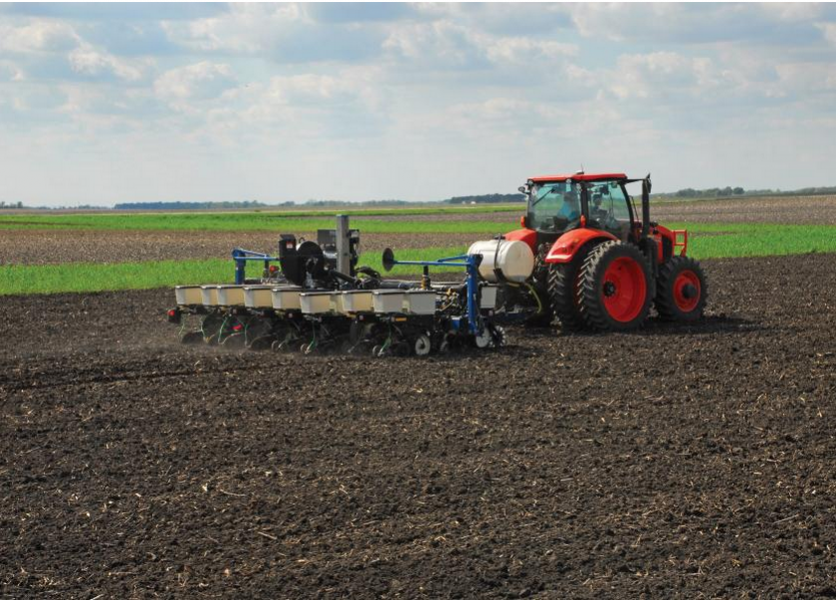5 Steps For Successful Early-Season Soybean Planting

Planting soybeans early can boost yield outcome, but that practice alone doesn’t guarantee you’ll combine more beans next fall. Before you hook up the planter, consider these 5 steps that can help you think through the process and implement sound planting decisions. These recommendations originated from the Farm Journal High-Yield Soybean Series developed by Farm Journal Field Agronomist Ken Ferrie and Writer, Darrell Smith.
1. Resolve any potential labor and equipment conflicts. Assess how you were using man hours in past years that you’ll now need to devote to early soybean planting. Maybe your team was spraying herbicides or spreading manure. Can you shift jobs around to get everything done?
Keep one rule uppermost in mind: Never delay corn planting. “Once conditions are ideal, you must plant corn,” Ferrie says. “If you miss the sweet spot, you could lose a ½ bu. to 1 bu. per acre for each day’s delay.”
There are various solutions to bottlenecks. For instance, you can plant soybeans, switch to corn when conditions are right and then finish soybeans whenever you can. “That mitigates risk by spreading out soybean maturity,” Ferrie says.
To plant most of your soybeans early, you will probably need to add a planter. “Some farmers tell me the increased yield of early-planted soybeans paid for their soybean planter in just one year,” Ferrie says.
Learn more about how to address labor and equipment needs at Eight Steps to Early Soybean Planting
2. Make sure you use varieties that reduce weather risk. Adverse weather conditions when plants are at the R1 or R2 growth stage result in flower and pod abortion. At the R3 and R4 growth stages, the result will be two-bean or three-bean pods with flat sections. At R5 and R6, drought will cause smaller beans.
“If early planted soybeans run into stress at any of these stages, they might produce fewer flowers or pods or smaller beans; so you might not see the expected yield benefit,” explains Ferrie, owner of Crop-Tech Consulting, Inc., near Heyworth, Ill.
“You can mitigate against adverse weather by planting multiple maturity ranges, so you never have your entire soybean crop at the same growth stage at the same time,” Ferrie continues. “That will smooth out harvest too — no over-ripe soybeans spilling out of pods and no wasted days waiting for all the soybeans to mature.”
3. Plant later soybean maturities first. If you plant multiple corn hybrids of the same maturity, you can mitigate weather risk by staggering planting dates. That doesn’t work with soybeans, because they flower based on the length of night.
“Based on our observations, we must plant full-season soybeans early enough to reach at least the three-trifoliate stage before the pre-solstice nights get too short,” Ferrie says. “There’s more time to get your short-season varieties planted early because they need fewer hours of darkness to trigger flowering.”
If early planted soybeans don’t get big enough to start flowering before the solstice, they will produce tall plants.
“The plants will continue to grow, adding vegetative stages until they reach R5 because flowering will be delayed until the nights get long enough after the solstice to trigger the reproductive stage. Tall plants don’t correlate with a yield increase. In two decades of studies, we have seen shoulder-high plants lodge more often and yield less than waist-high plants,” Ferrie says.
You can learn more about this topic at Tips for Planting Soybeans Earlier
4. Make sure you can implement your weed-control program. “With early planting, the time frame for applying burndown, preplant and pre-emergence soybean herbicides is likely to coincide with corn planting,” says Ferrie. “If your custom applicator is applying preplant and pre-emergence herbicides on corn, he might not want to stop, clean out a sprayer and apply soybean herbicides. I’ve seen soybean planting delayed three weeks while growers waited for a burndown herbicide application.”
Along with that, you also might need to consider a different option, such as using a pre-emergence soil-applied herbicide with residual control, Ferrie says, as a for instance.
“Follow that with a post-emergence application, applied a little earlier than you are used to. You might need to include a residual herbicide in the post-emergence treatment.”
Check out Ferrie’s other weed-control strategies in this article: Control Weeds in Early-Planted Soybeans
5. Evaluate the potential impact your planting date can have on replant decisions. Replant charts are based on normal planting dates. Because early-planted soybeans flower before the summer solstice, they have greater yield potential — higher than existing stand charts reflect.
“In 2015, when many soybeans were planted early, followed by poor stand establishment, many fields with only 50,000 to 55,000 surviving plants per acre yielded in the mid-80-bu. range,” Ferrie says. “Similar fields that were replanted later yielded in the mid- to low-60s.
“If you tear up early-planted soybeans you will miss pre-solstice flowering,” Ferrie explains. “If you interplant, some plants will flower before the solstice and some after.”
If you keep a low stand, plan to manage weeds. “You might need to walk or row-cultivate,” Ferrie says. “With GMO varieties you might be able to apply Liberty or 2,4-D herbicides later in the season.
“But with non-GMOs, be careful not to burn soybeans in the reproductive stage. Another option is to accept a lower yield and interplant soybeans solely for increased weed control.” Learn more here: Planting Date Affects Replant Decisions







